|
|
|
Sort Order |
|
|
|
Items / Page
|
|
|
|
|
|
|
| Srl | Item |
| 1 |
ID:
192097
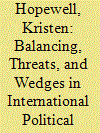

|
|
|
|
|
| Summary/Abstract |
Despite considerable tensions, China and India formed a surprising alliance at the WTO. Their alliance proved highly successful, bringing an end to American dominance and sharply curtailing the ability of the US to set the rules of global trade. However, the article shows, a key risk of soft balancing within an international institution is that, if successful, it may cause the dominant power to abandon the institution altogether. The US responded to China and India’s soft balancing by turning away from the WTO, actively undermining its rules and enforcement mechanism, and pursuing its interests through bilateral channels. The article thus identifies a distinct and previously unrecognized wedge strategy—vertical forum-shifting, or moving the action from international institutions to bilateral negotiations, to split an adversary coalition.
|
|
|
|
|
|
|
|
|
|
|
|
|
|
|
|
| 2 |
ID:
192101


|
|
|
|
|
| Summary/Abstract |
How did the Belt and Road Initiative (BRI) shape the volume and destination of Chinese greenfield foreign direct investments (GFDI)? This article examines Chinese GFDI in Indonesia, Malaysia, the Philippines, and Myanmar using quantitative and qualitative data. Results show first, that the BRI led to a surge of investments by firms with stronger government affiliation in sectors related to infrastructure and connectivity. In contrast, the BRI had limited effect on firms in consumption-related industries that are primarily small and privately owned. Second, the change in sectoral destination of Chinese GFDI after the BRI is explained by the strength of diplomatic bilateral relations, which generate government support for investments in specific industries, and by host market conditions, such as favourable regulatory environments and positive economy outlook.
|
|
|
|
|
|
|
|
|
|
|
|
|
|
|
|
| 3 |
ID:
192100
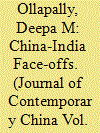

|
|
|
|
|
| Summary/Abstract |
This article examines five direct border conflicts between China and India to study how well the reputational effects of their crisis management conformed to conventional deterrence expectations. This article finds that how these crises are settled suggests that instead of deterrence expectations of resolve-oriented behavior, China and India have engaged in reassurance-oriented behavior. Answering why reassurance has taken precedence over resolve even under crises conditions, it is argued that despite the two countries being at odds on the specific and highly salient border issue, they recognize the value of broader joint gains, which in turn is buttressed by a shared ‘post-colonial’ identity and common worldview on questions of global order.
|
|
|
|
|
|
|
|
|
|
|
|
|
|
|
|
| 4 |
ID:
192099


|
|
|
|
|
| Summary/Abstract |
This article examines Sino-Indian border disputes in the post-Cold War period. There has been an increased frequency of Chinese military coercion in the Sino-Indian border disputes since 2006. This trend contrasts with Chinese coercion in the South China Sea in the post-2007 period, which tends to be non-militarized. Why does China prefer to use military coercion regarding Sino-Indian border disputes? This article argues that the geopolitical backlash cost for China to use military coercion against India has been low since the 1990s, and China, therefore, has consistently used militarized coercive tools. In contrast, the high geopolitical backlash cost pertaining to South China Sea disputes led China to utilize non-military coercion post-2007. This article implications for theorizing China’s choices of coercive tools and its India policy.
|
|
|
|
|
|
|
|
|
|
|
|
|
|
|
|
| 5 |
ID:
192104


|
|
|
|
|
| Summary/Abstract |
The Express Railway Link (XRL) offers unprecedented mobility within the Pearl River Delta and connects Hong Kong to mainland China’s high-speed rail network. As reflected in the pages of regional and national newspapers, the XRL figures prominently in the re-imagining of scales of community and governance in the Pearl River Delta. These ‘infrastructural imaginaries’ are shaped not just by the transportation infrastructure of trains and stations, but also by the migration infrastructure of travel permits and identification cards. Drawing on infrastructure studies and the politics of scale to shed light on the multi-scalar politics of infrastructure in contemporary China, this article traces how understandings of infrastructure and scale changed as the XRL went from regional project to one component of China’s national high-speed rail grid.
|
|
|
|
|
|
|
|
|
|
|
|
|
|
|
|
| 6 |
ID:
192096


|
|
|
|
|
| Summary/Abstract |
Recent China-India relations have been marked by a puzzling mix of cooperation and rivalry across military, economic, institutional and normative dimensions. Yet despite a large empirical literature on this crucial relationship, existing scholarship has struggled to explain its countervailing trends. This is due in large part to a lack of rigorous theory, which is essential for explanation. This article illustrates the theoretical shortcomings of current scholarship on China-India relations, drawing on the methodological literature on causal inference. It then shows how the four articles that follow in the special issue serve as a much-needed corrective to this problem by developing and applying well-specified theories to explain variation in China-India cooperation and rivalry, and presents a synthesis of their causal claims.
|
|
|
|
|
|
|
|
|
|
|
|
|
|
|
|
| 7 |
ID:
192105
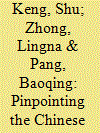

|
|
|
|
|
| Summary/Abstract |
In China, too many leadership positions are assigned to the same broad administrative levels, creating difficulty in distinguishing their specific political rankings. Pinpointing their exact political significance, this study proposes an index using the common joint appointments of party and government positions in the Chinese Nomenklatura. After coming up with the index, to demonstrate applicability, this article uses it first to assess China’s provincial-level positions and then extend it down to prefecture-level and up to Central ministerial positions. The authors believe that this new index enables better observation and interpretation of China’s leadership transfers and, consequently, improves researchers’ understanding of the prospects of Chinese politicians and the dynamics of the Chinese polity.
|
|
|
|
|
|
|
|
|
|
|
|
|
|
|
|
| 8 |
ID:
192102
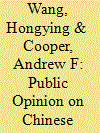

|
|
|
|
|
| Summary/Abstract |
The expanding profile of Chinese international development aid has generated strong academic and policy interests. A growing literature has emerged on Chinese foreign aid’s motivations, modalities, and impact. However, a significant lacuna remains in the domestic politics relating to this phenomenon. This gap is especially glaring in public opinion concerning China’s growing foreign aid programs. By analyzing empirical data gathered from a variety of sources, including a well-established online forum, social media sites of two influential media organizations, and multi-year surveys of residents of Beijing, this paper presents a nuanced picture of what the Chinese public thinks of Chinese foreign aid and tests two popular explanations of public opposition to foreign aid—perceived budgetary trade-offs and more general dissatisfaction with government policies.
|
|
|
|
|
|
|
|
|
|
|
|
|
|
|
|
| 9 |
ID:
192103


|
|
|
|
|
| Summary/Abstract |
In this article, the authors investigate how the Belt and Road Initiative (BRI) may affect China’s global image. They find evidence that international opinions on China are diverse but not polarized. They also find that the BRI has curried favor for China in the related countries. On average, the BRI increases the net public approval rating of the Chinese leadership in these countries by 15 percentage points. Interestingly, the BRI arouses approving foreign opinions more than quietens disapproving voices. Furthermore, there is tentative evidence suggesting that the BRI impacts China’s global reputation through trade, infrastructure, debt, and people-people interactions. Lastly, respondents who are older, better educated, with a higher income, and living in urban areas viewed China more favorably after the launch of the BRI.
|
|
|
|
|
|
|
|
|
|
|
|
|
|
|
|
| 10 |
ID:
192098
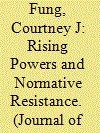

|
|
|
|
|
| Summary/Abstract |
What explains rising powers’ approach to emerging norms that challenge ontological order? The article uses a controlled comparison of two rising powers, China and India, as they address the responsibility to protect, which reconceives state sovereignty as contingent. Both states rejected the norm at its inception, before diverging as UN Security Council members during norm application in the Libya intervention. China assumed a creative resister role, offering tactical concessions, while using traditional sovereignty norms to renovate norm content. India assumed a norm begrudger role, typified by rhetorical rejection and disengagement from evolving normative discourse, coupled with practical support for the responsibility to protect. These rising powers’ normative roles are shaped by their dual status and differing positions within the UN Security Council social environment.
|
|
|
|
|
|
|
|
|
|
|
|
|
|
|
|
|
|
|
|
|